The Effects of Flexible Cylinder Structural Dynamics to the near Wake Turbulence
Abstract
:1. Introduction
2. Materials and Methods
2.1. Experimental Analysis
2.2. Turbulence Quantification
3. Results and Discussion
3.1. Time Averaged Velocity Distribution
3.2. Turbulence Intensity
3.3. Turbulence Kinetic Energy Budget
3.4. Reynolds Stresses
3.5. Roles of Oscillation of the Flexible Cylinder in the Turbulence Enhancement
4. Conclusions
Author Contributions
Funding
Data Availability Statement
Conflicts of Interest
References
- Pattenden, R.J.; Turnock, S.R.; Zhang, X. Measurements of the flow over a low-aspect-ratio cylinder mounted on a ground plane. Exp. Fluids 2005, 39, 10–21. [Google Scholar] [CrossRef]
- Aris, M.; Owen, I.; Sutcliffe, C. The development of active vortex generators from shape memory alloys for the convective cooling of heated surfaces. Int. J. Heat Mass Transf. 2011, 54, 3566–3574. [Google Scholar] [CrossRef]
- Zahari, M.; Chan, H.B.; Yong, T.H.; Dol, S.S. The effects of spring stiffness on vortex-induced vibration for energy generation. In IOP Conference Series: Materials Science and Engineering; IOP Publishing: Bristol, UK, 2015; Volume 78, p. 012041. [Google Scholar]
- Tomomichi, N.; Kaneko, S.; Inada, F.; Kato, M.; Ishihara, K.; Nishihara, T.; Mureithi, N.W.; Langthjem, M.A. (Eds.) Flow-Induced Vibrations: Classifications and Lessons from Practical Experiences; Butterworth-Heinemann: Oxford, UK, 2013. [Google Scholar]
- Bai, Y.; Bai, Q. (Eds.) Subsea Pipelines and Risers; Elsevier: Amsterdam, The Netherlands, 2005. [Google Scholar]
- Yong, T.H.; Chan, H.B.; Dol, S.S.; Wee, S.K.; Sulaiman, S.A. Experimental Investigation on Effects of Elastic Agitator to Turbulence Enhancement. J. Appl. Fluid Mech. 2020, 14, 361–373. [Google Scholar]
- Kitagawa, T.; Fujino, Y.; Kimura, K.; Mizuno, Y. Wind pressures measurement on end-cell-induced vibration of a cantilevered circular cylinder. J. Wind. Eng. Ind. Aerodyn. 2002, 90, 395–405. [Google Scholar] [CrossRef]
- Sumner, D.; Heseltine, J.L.; Dansereau, O.J.P. Wake structure of a finite circular cylinder of small aspect ratio. Exp. Fluids 2004, 37, 720–730. [Google Scholar] [CrossRef]
- Luo, S.C. Flow past a finite length circular cylinder. In Proceedings of the Third International Offshore and Polar Engineering Conference, Singapore, 6 June 1993. [Google Scholar]
- Taniguchi, S.; Sakamoto, H.; Arie, M. Flow around Circular Cylinders of Finite Height Placed Vertically in Turbulent Boundary Layers. Bull. JSME 1981, 24, 37–44. [Google Scholar] [CrossRef]
- Park, C.-W.; Lee, S.-J. Flow structure around a finite circular cylinder embedded in various atmospheric boundary layers. Fluid Dyn. Res. 2002, 30, 197–215. [Google Scholar] [CrossRef]
- Liu, Y.; So, R.; Cui, Z. A finite cantilevered cylinder in a cross-flow. J. Fluids Struct. 2005, 20, 589–609. [Google Scholar] [CrossRef]
- Rostamy, N.; Sumner, D.; Bergstrom, D.; Bugg, J. Local flow field of a surface-mounted finite circular cylinder. J. Fluids Struct. 2012, 34, 105–122. [Google Scholar] [CrossRef]
- Park, C.; Lee, S. Effects of free-end corner shape on flow structure around a finite cylinder. J. Fluids Struct. 2004, 19, 141–158. [Google Scholar] [CrossRef]
- Adaramola, M.S. The Wake of an Exhaust Stack in a Crossflow. Ph.D. Thseis, Department of Mechanical Engineering, University of Saskatchewan, Saskatoon, SK, Canada, 2008. [Google Scholar]
- Govardhan, R.; Williamson, C. Mean and fluctuating velocity fields in the wake of a freely-vibrating cylinder. J. Fluids Struct. 2001, 15, 489–501. [Google Scholar] [CrossRef]
- Cantwell, B.; Coles, D. An experimental study of entrainment and transport in the turbulent near wake of a circular cylinder. J. Fluid Mech. 1983, 136, 321–374. [Google Scholar] [CrossRef]
- Yong, T.H.; Chan, H.B.; Dol, S.S.; Wee, S.K.; Kumar, P. The flow dynamics behind a flexible finite cylinder as a flexible agitator. IOP Conf. Ser. Mater. Sci. Eng. 2017, 206, 012033. [Google Scholar] [CrossRef]
- Dol, S.S.; Yong, T.H.; Bin Chan, H.; Wee, S.K.; Sulaiman, S.A. Turbulence Characteristics of the Flexible Circular Cylinder Agitator. Fluids 2021, 6, 238. [Google Scholar] [CrossRef]
- Yokoyama, K.; Kashiwaguma, N.; Okubo, T.; Takeda, Y. Flow measurement in an open channel by UVP. Proc. ISUD 2004, 4, 204–210. [Google Scholar]
- Jamshidnia, H.; Takeda, Y. UVP Measurement of Flow around a Baffle in a Rectangular Open Channel. J. Fluid Sci. Technol. 2009, 4, 758–774. [Google Scholar] [CrossRef]
- Park, C.W.; Lee, S.J. Free end effects on the near wake flow structure behind a finite circular cylinder. J. Wind. Eng. Ind. Aerodyn. 2000, 88, 231–246. [Google Scholar] [CrossRef]
- Coleman, H.W.; Steele, W.G. Experimentation and Uncertainty Analysis for Engineers, 2nd ed.; John Wiley and Sons, Inc.: New York, NY, USA, 1999; pp. 38–84. [Google Scholar]
- Mittal, S.; Kumar, V. Flow-induced vibrations of a light circular cylinder at reynolds numbers 103TO 104. J. Sound Vib. 2001, 245, 923–946. [Google Scholar] [CrossRef]
- Kuppan, T. Classification of Heat Exchanger. In Heat Exchanger Design Handbook, 2nd ed.; CRC Press Taylor & Francis Group: Boca Raton, FL, USA, 2013; pp. 1–27. [Google Scholar]
- Williamson, C.; Roshko, A. Vortex formation in the wake of an oscillating cylinder. J. Fluids Struct. 1988, 2, 355–381. [Google Scholar] [CrossRef]
- de Langre, E.; Gutierrez, A.; Cossé, J. On the scaling of drag reduction by reconfiguration in plants. Comptes Rendus Mécanique 2012, 340, 35–40. [Google Scholar] [CrossRef]
- Kang, Z.; Jia, L. An experiment study of a cylinder’s two degree of freedom VIV trajectories. Ocean Eng. 2013, 70, 129–140. [Google Scholar] [CrossRef]
- Kawamura, T.; Hiwada, M.; Hibino, T.; Mabuchi, I.; Kumada, M. Flow around a Finite Circular Cylinder on a Flat Plate : Cylinder height greater than turbulent boundary layer thickness. Bull. JSME 1984, 27, 2142–2151. [Google Scholar] [CrossRef]
- Sumner, D. Flow above the free end of a surface-mounted finite-height circular cylinder: A review. J. Fluids Struct. 2013, 43, 41–63. [Google Scholar] [CrossRef]


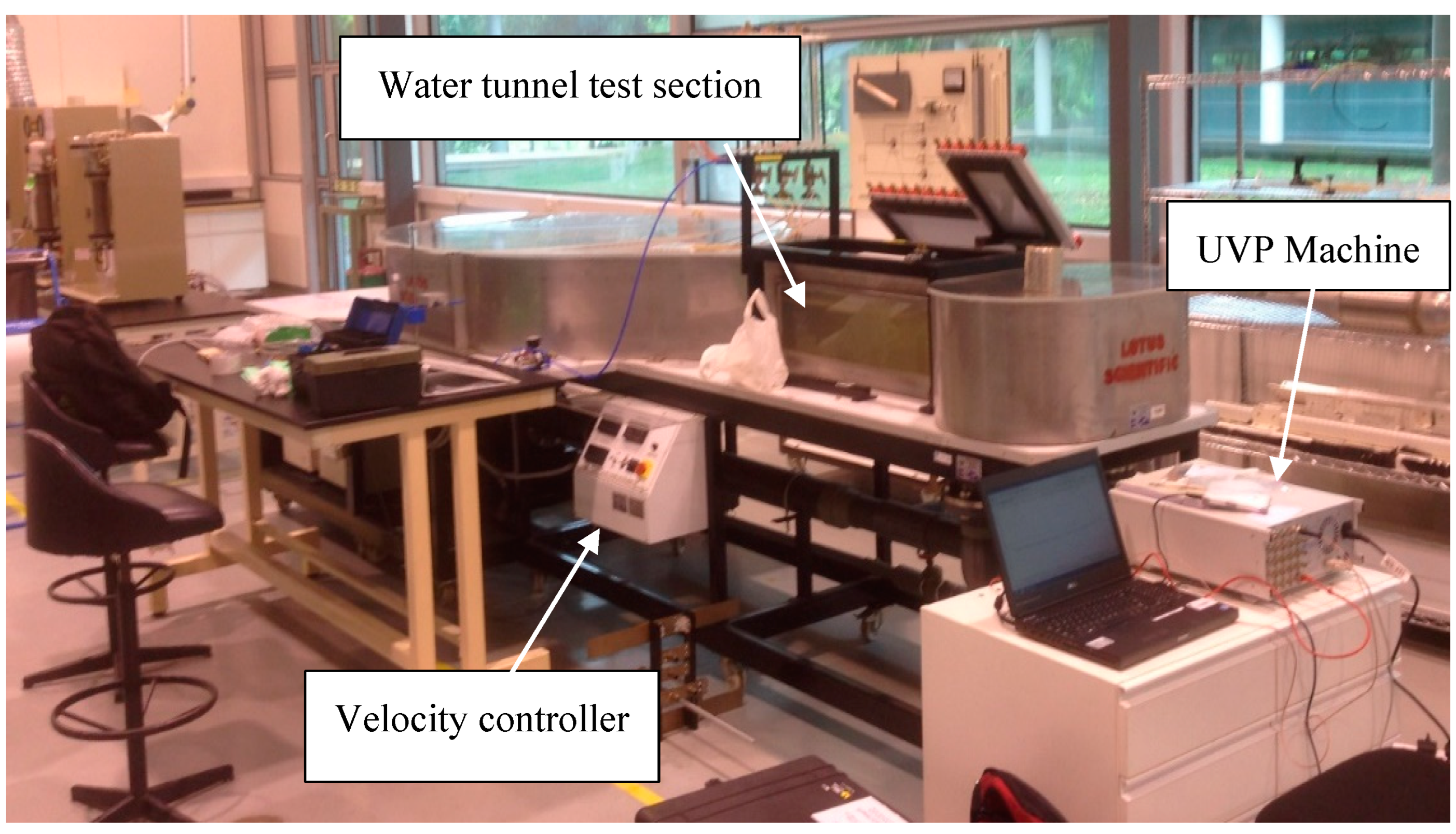

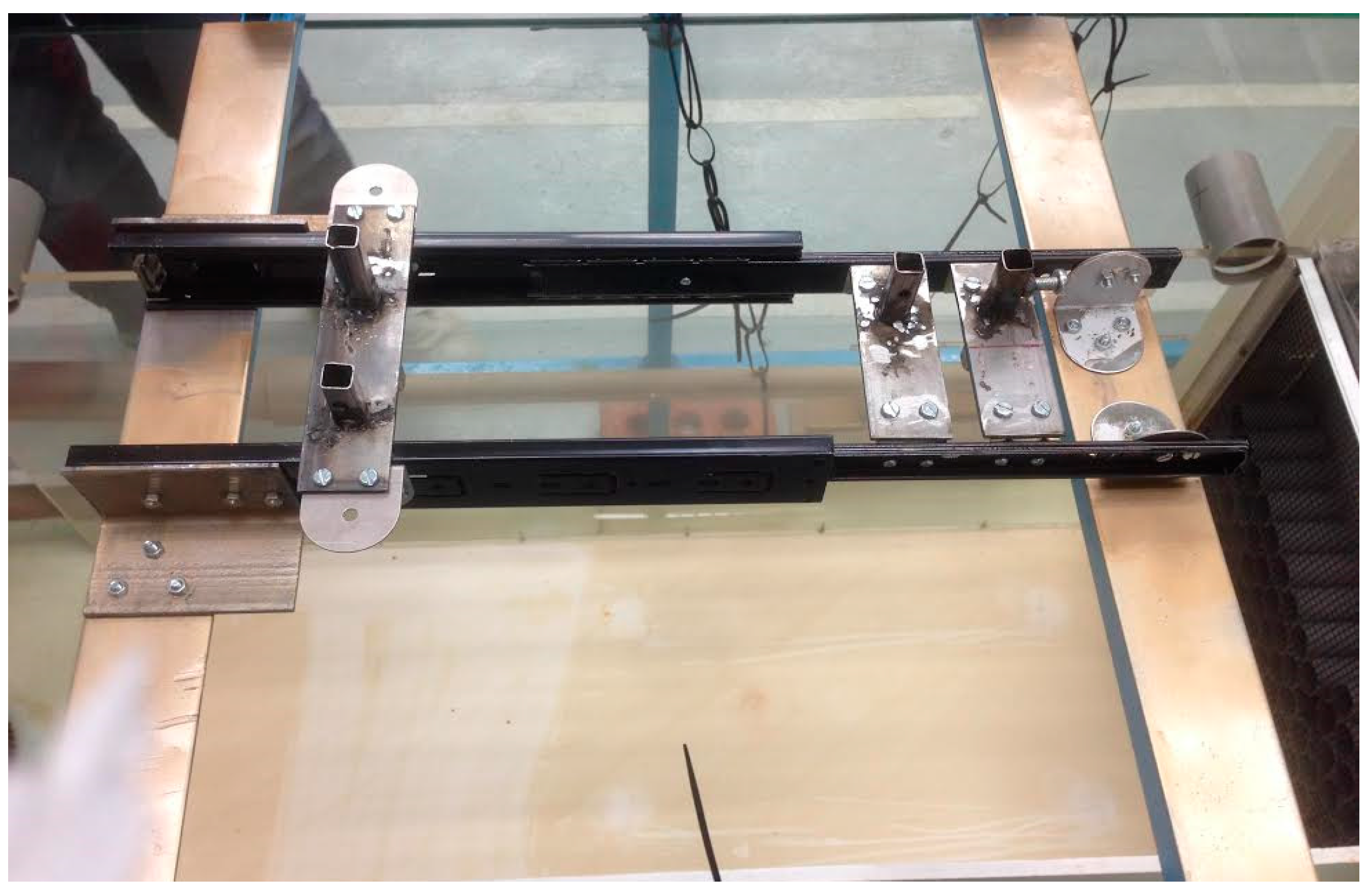
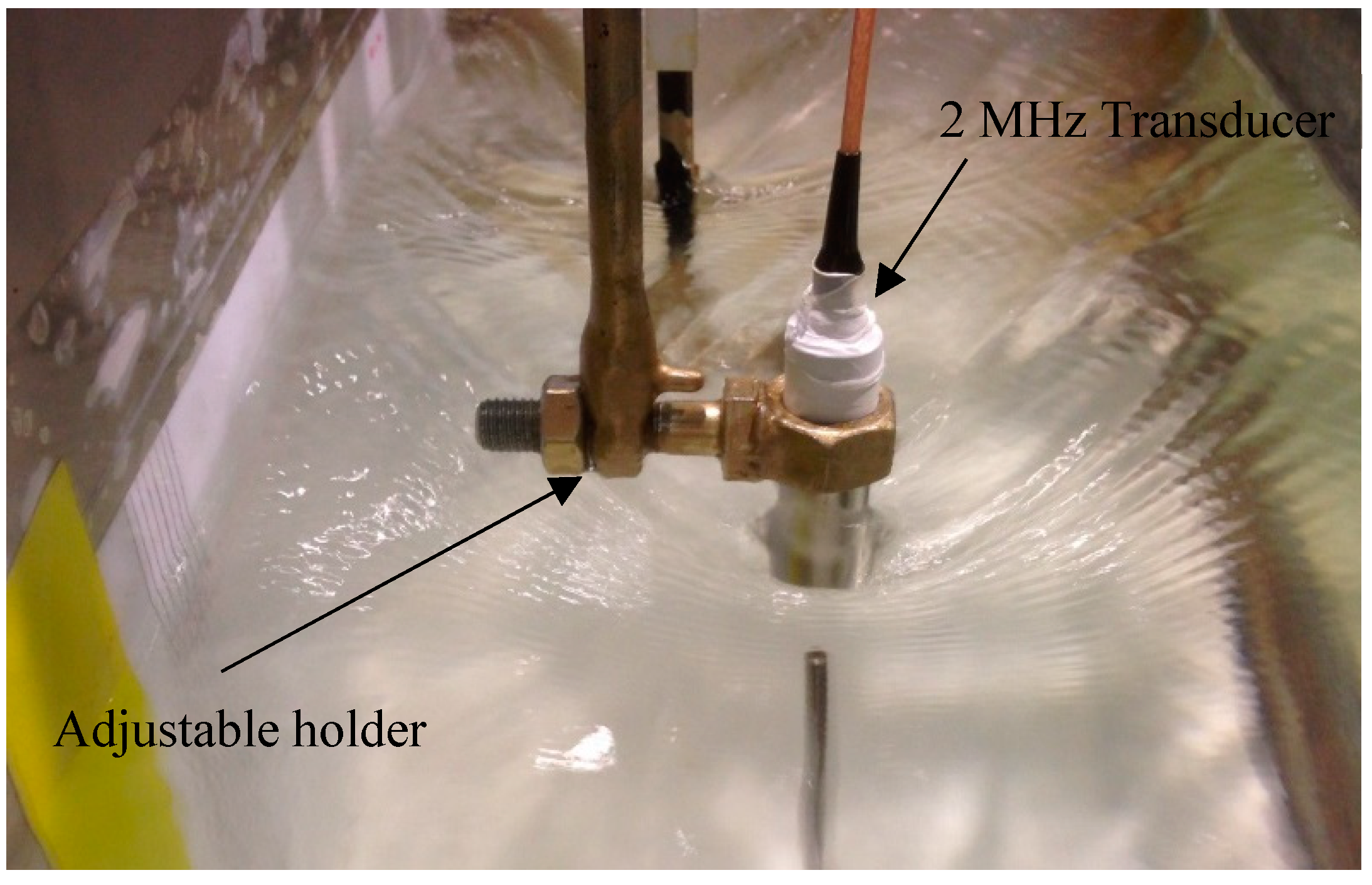
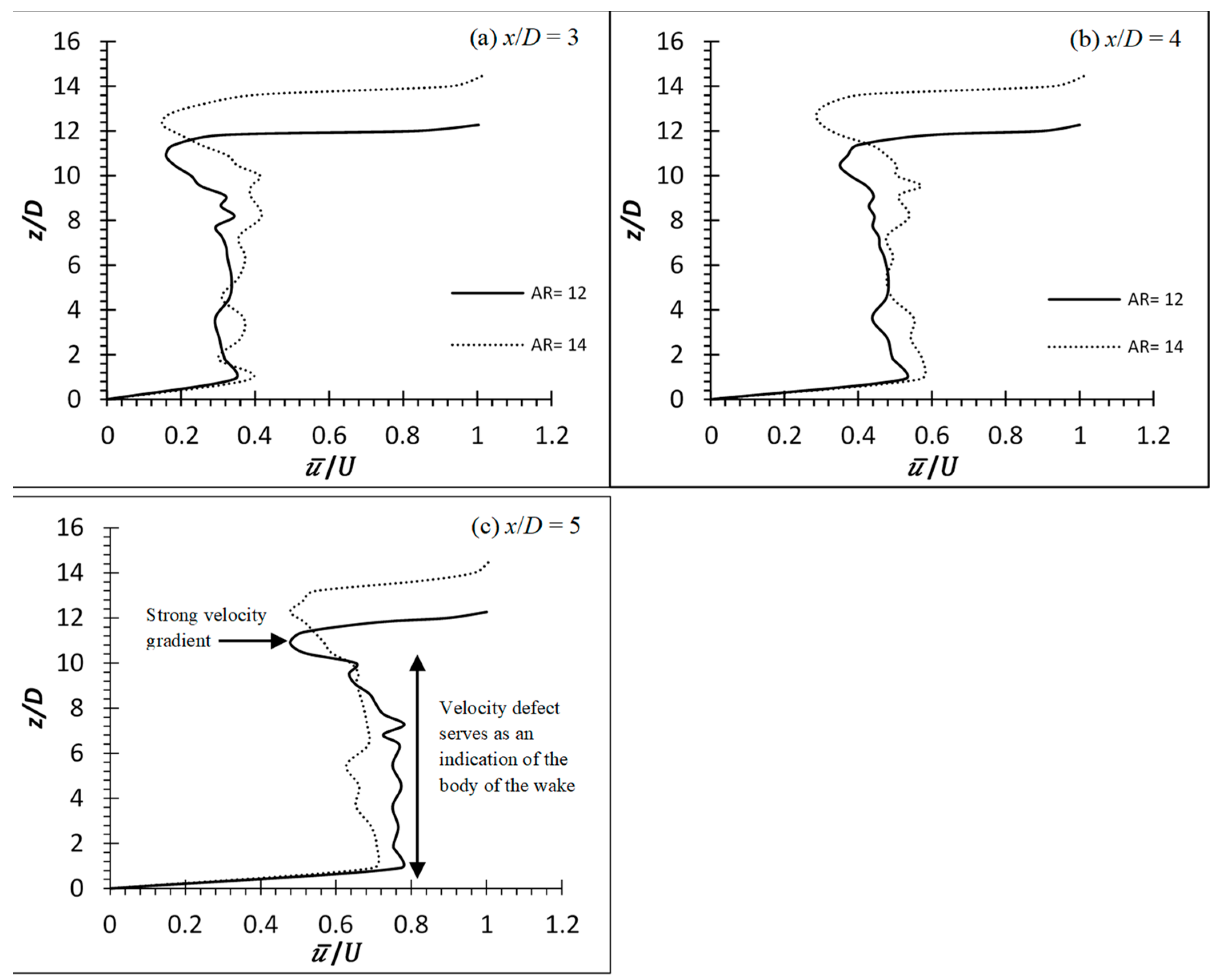
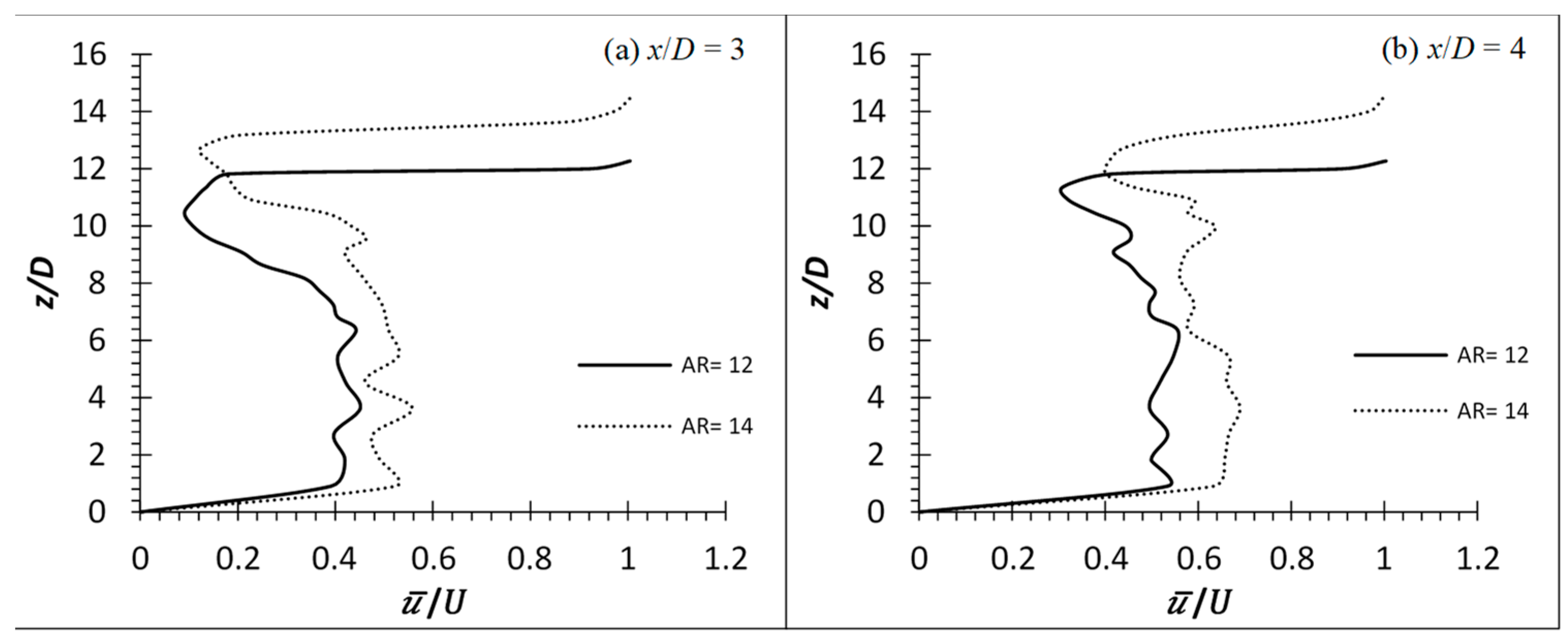
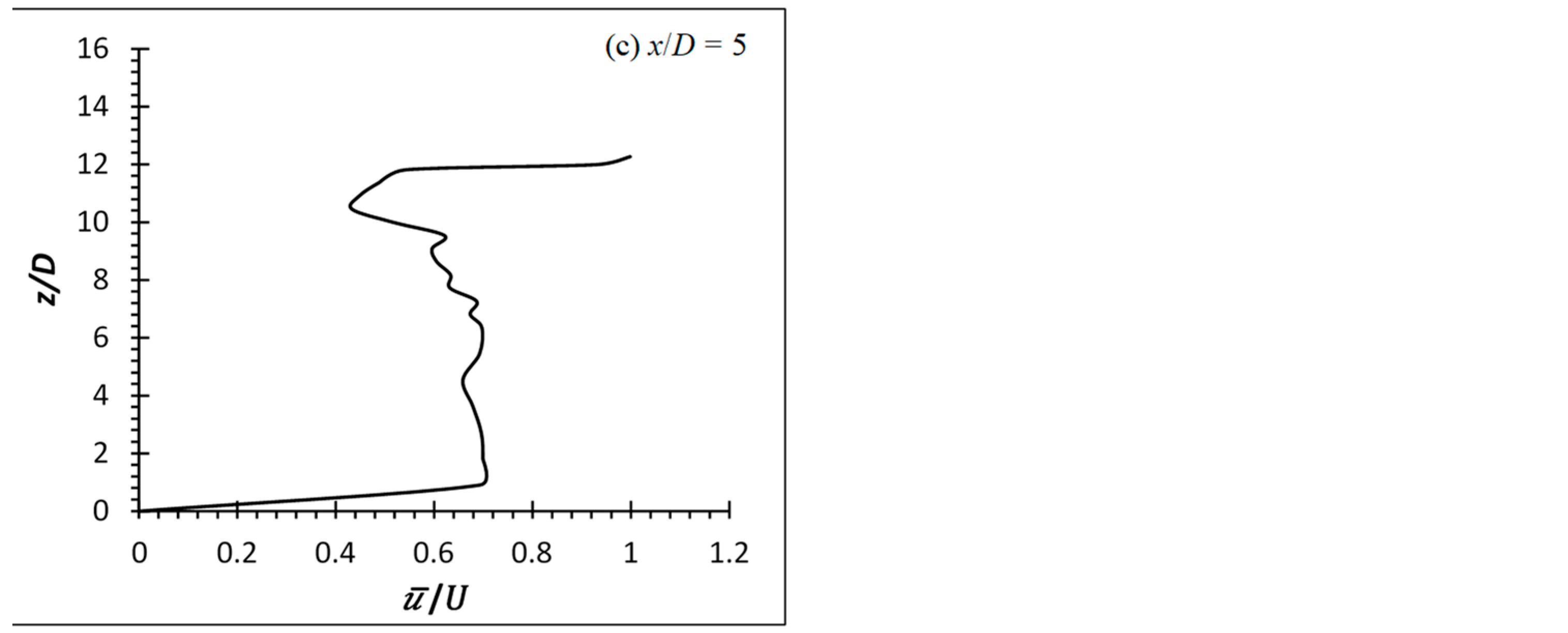


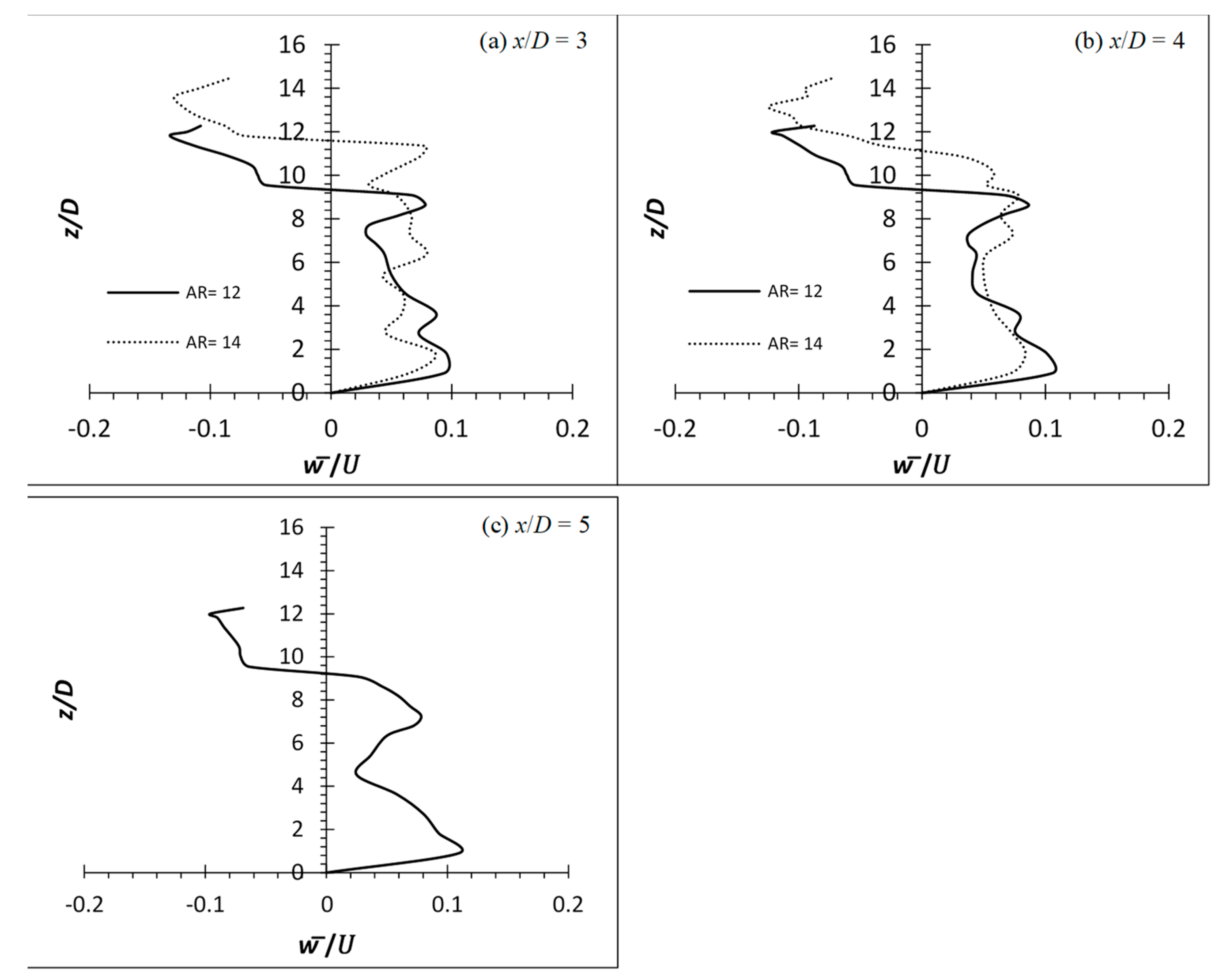
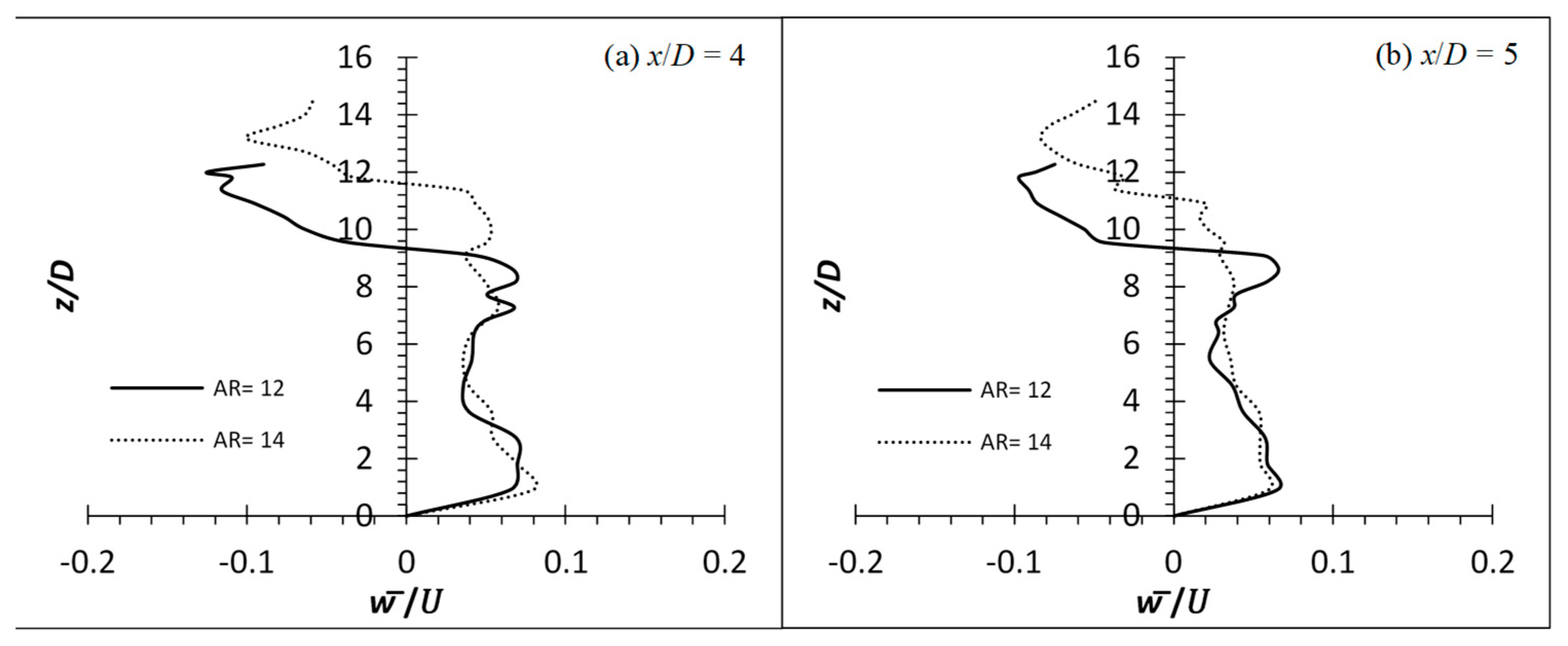
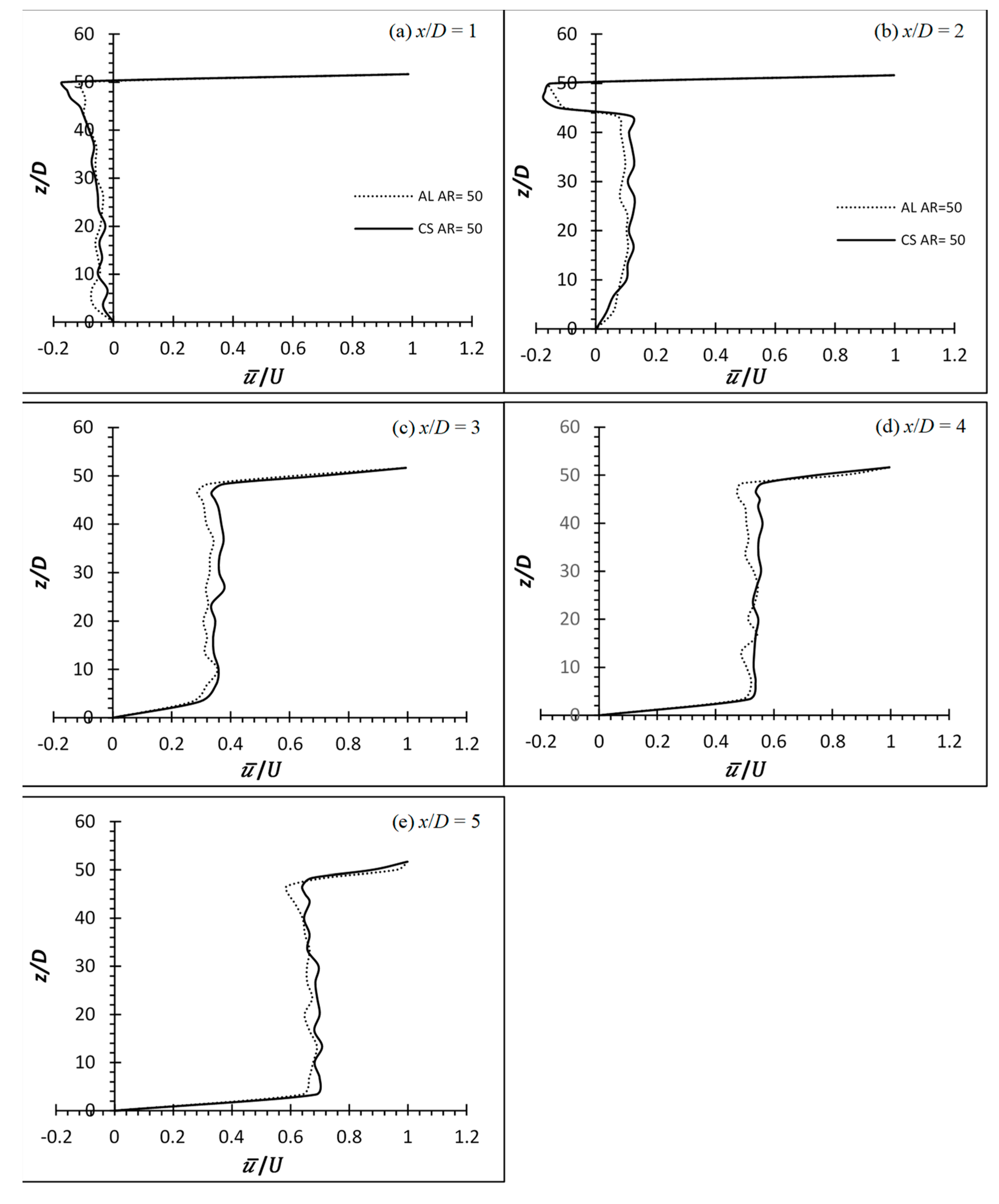

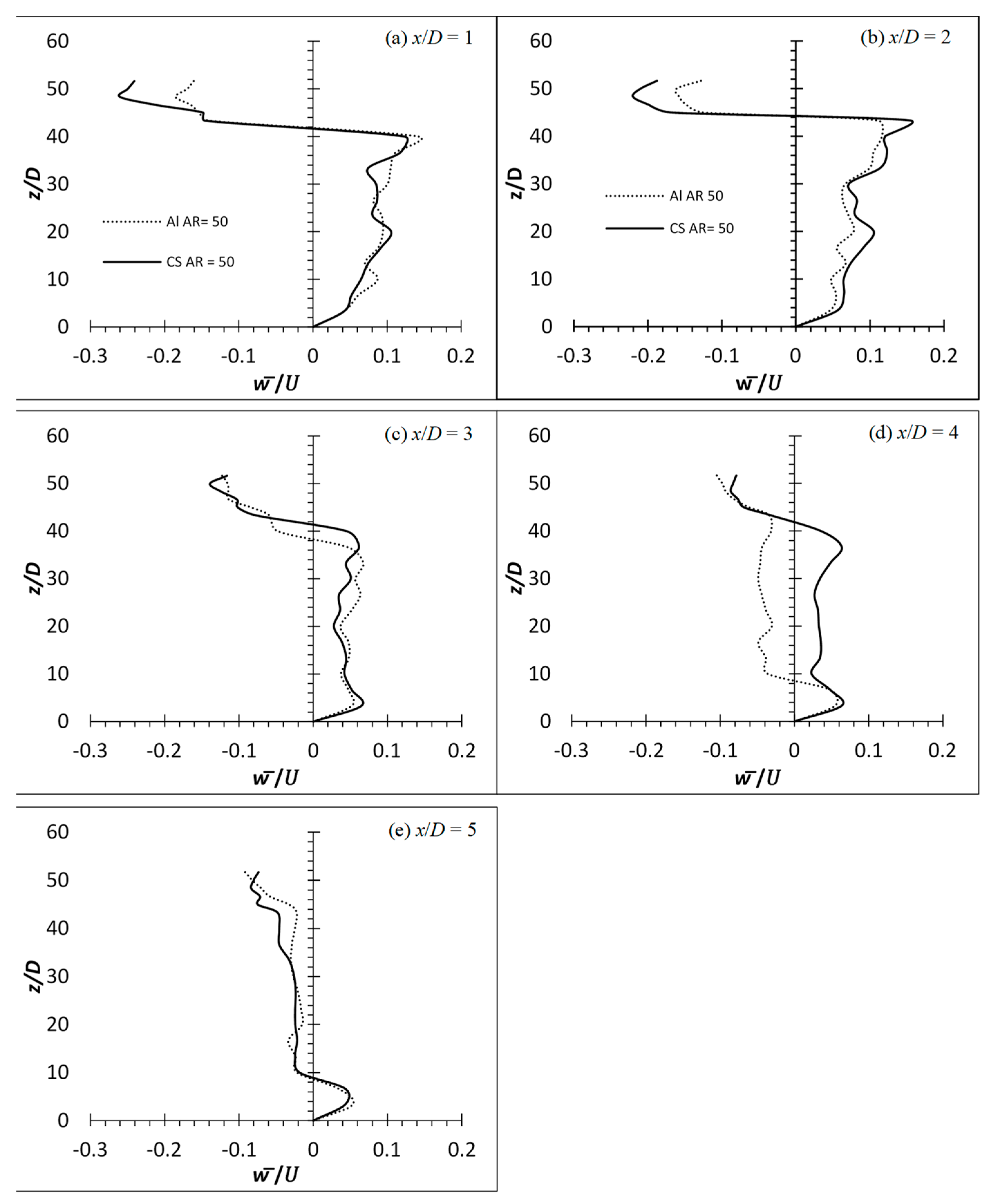
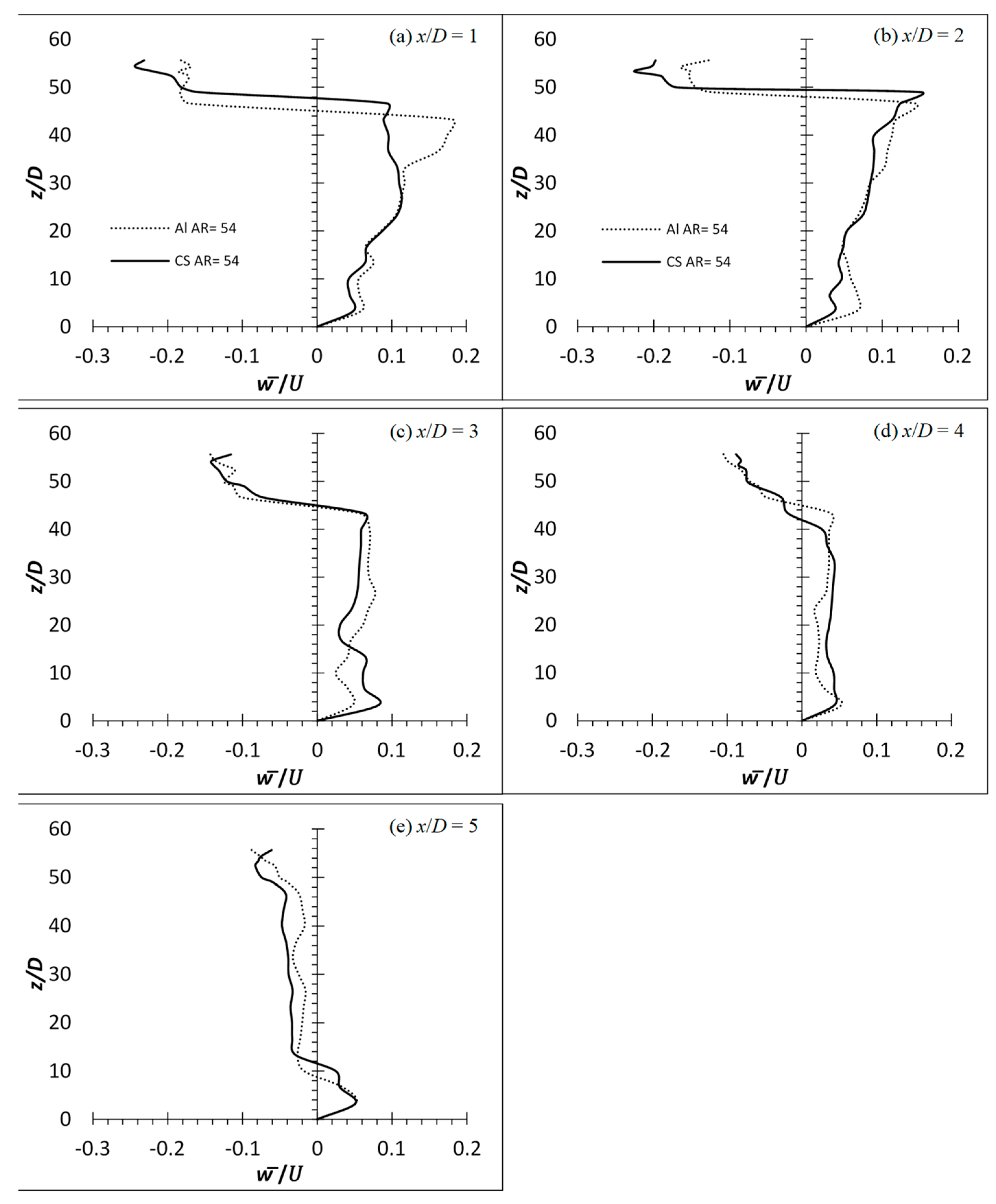
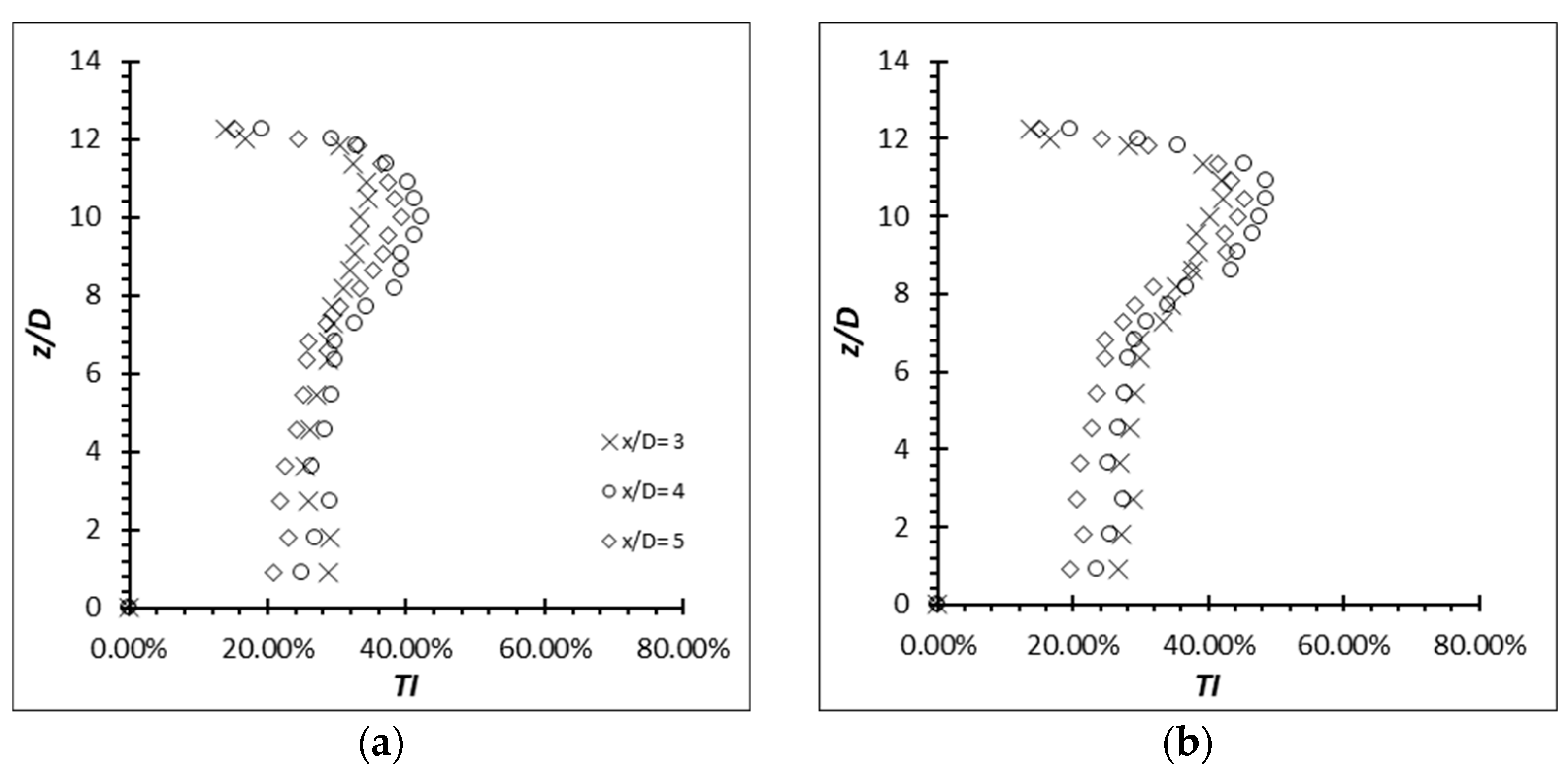

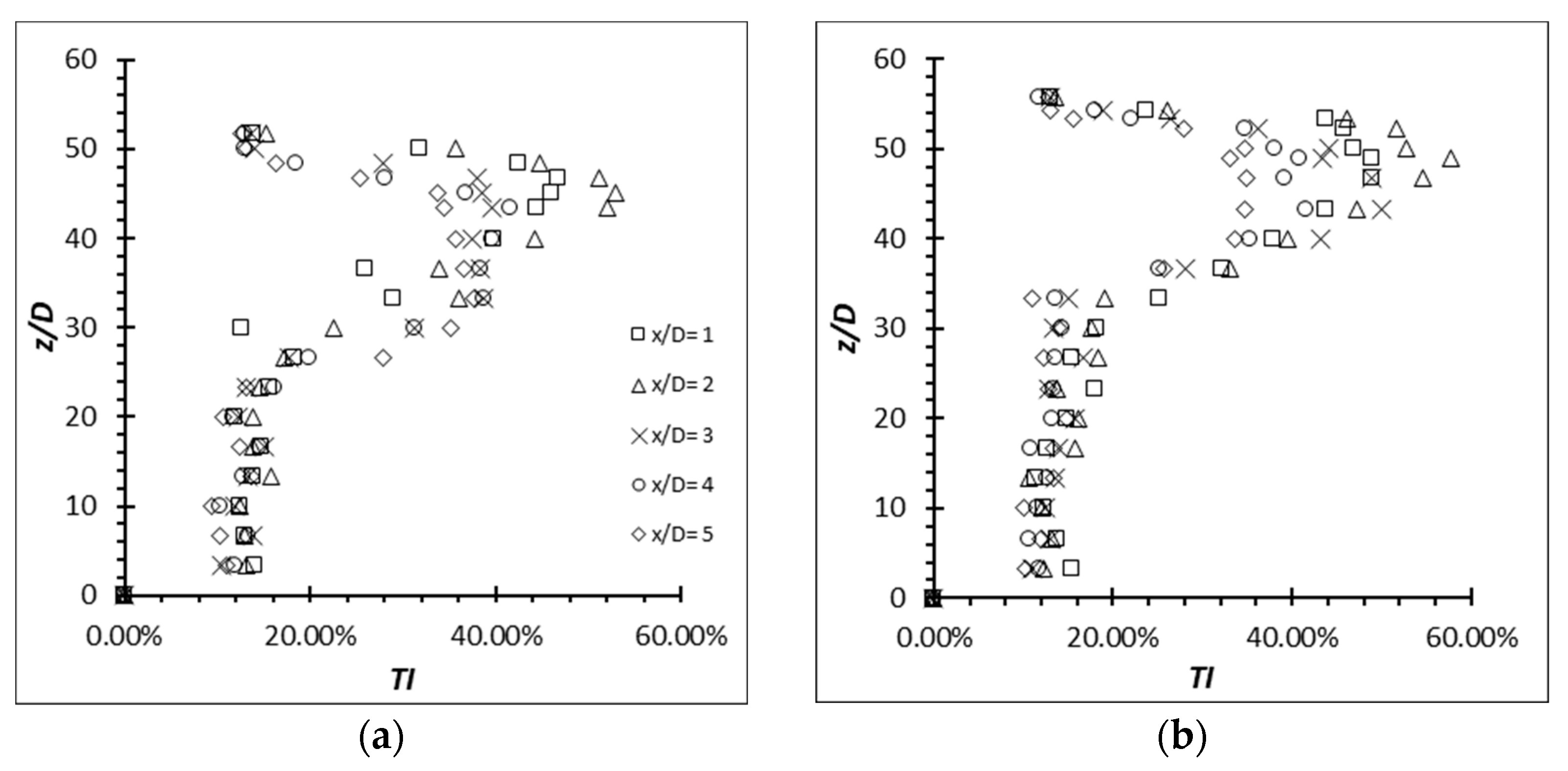

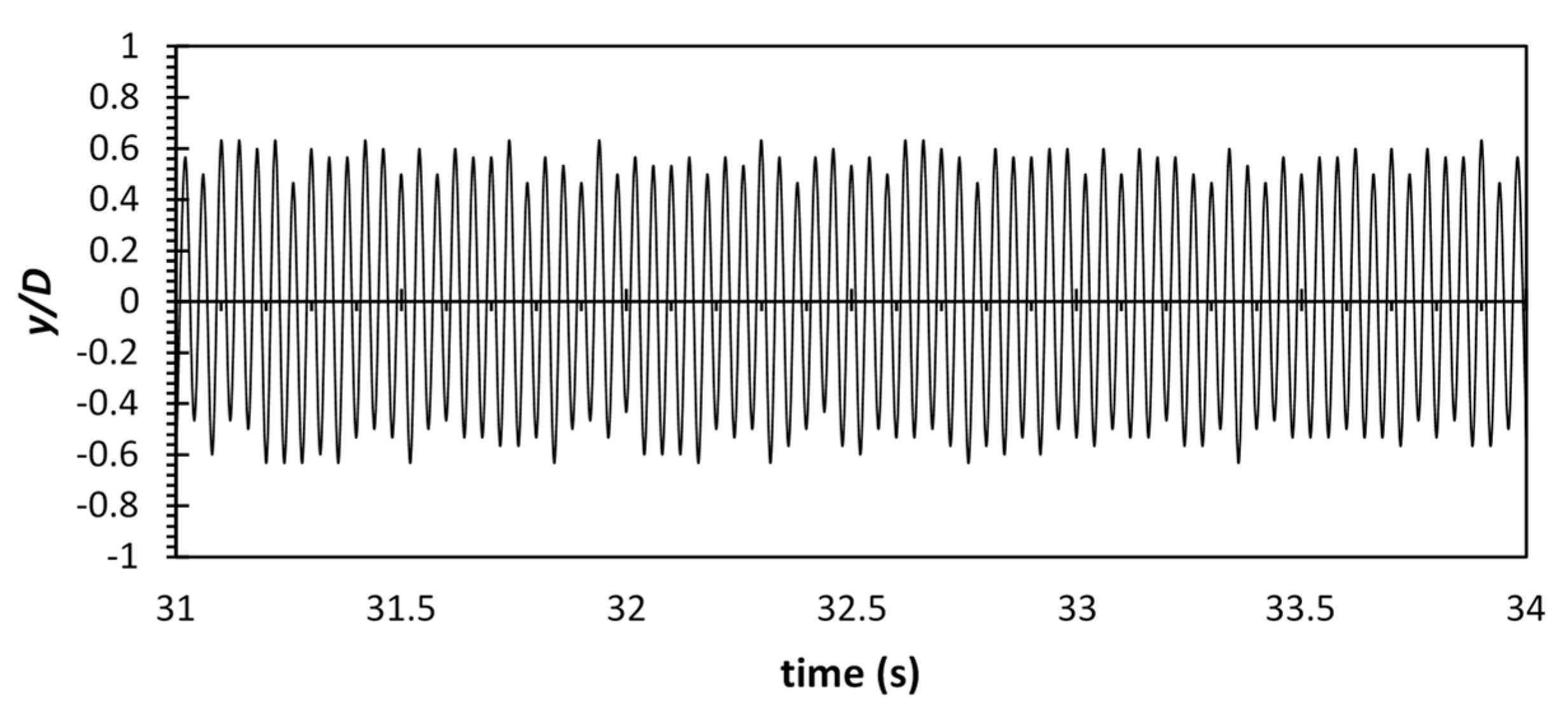
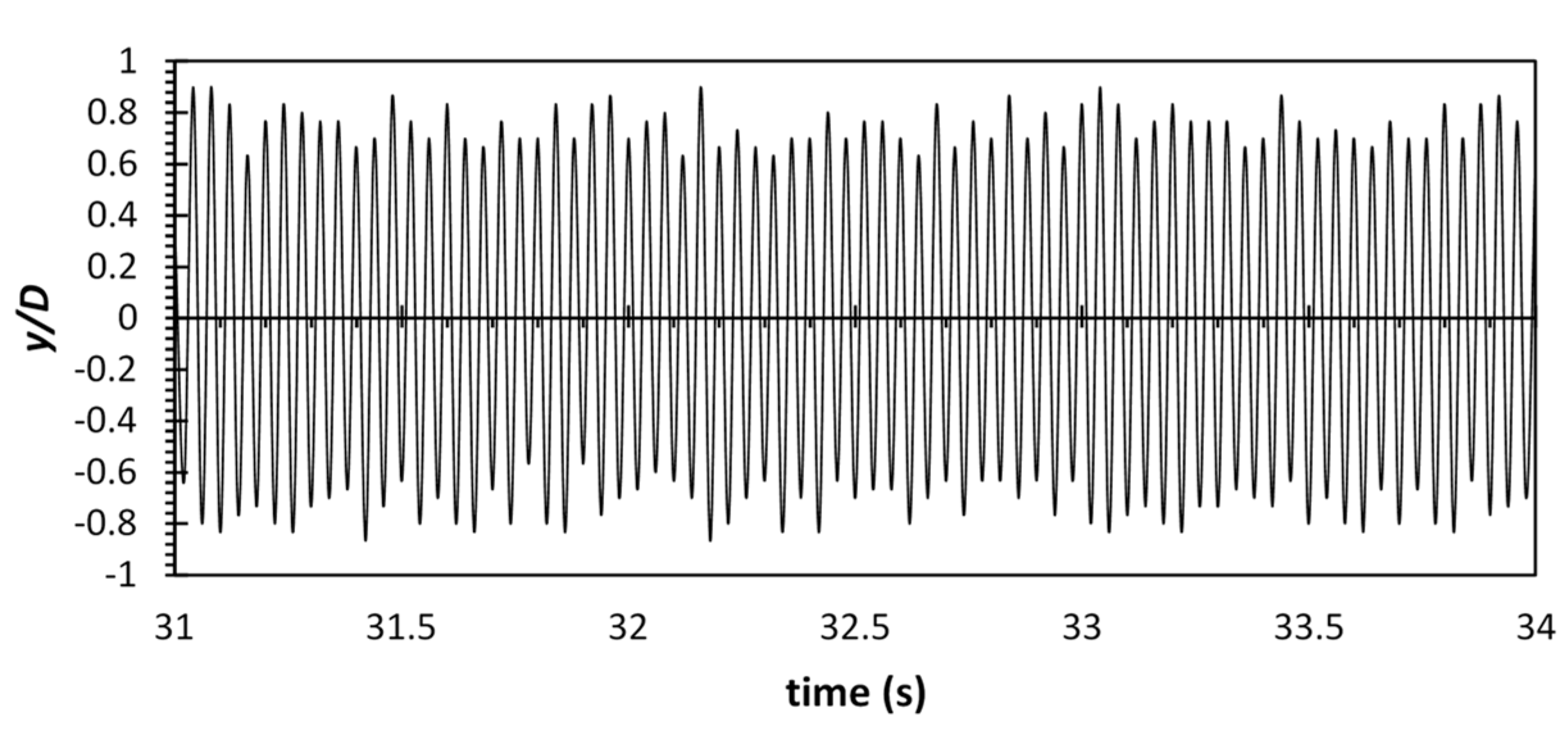
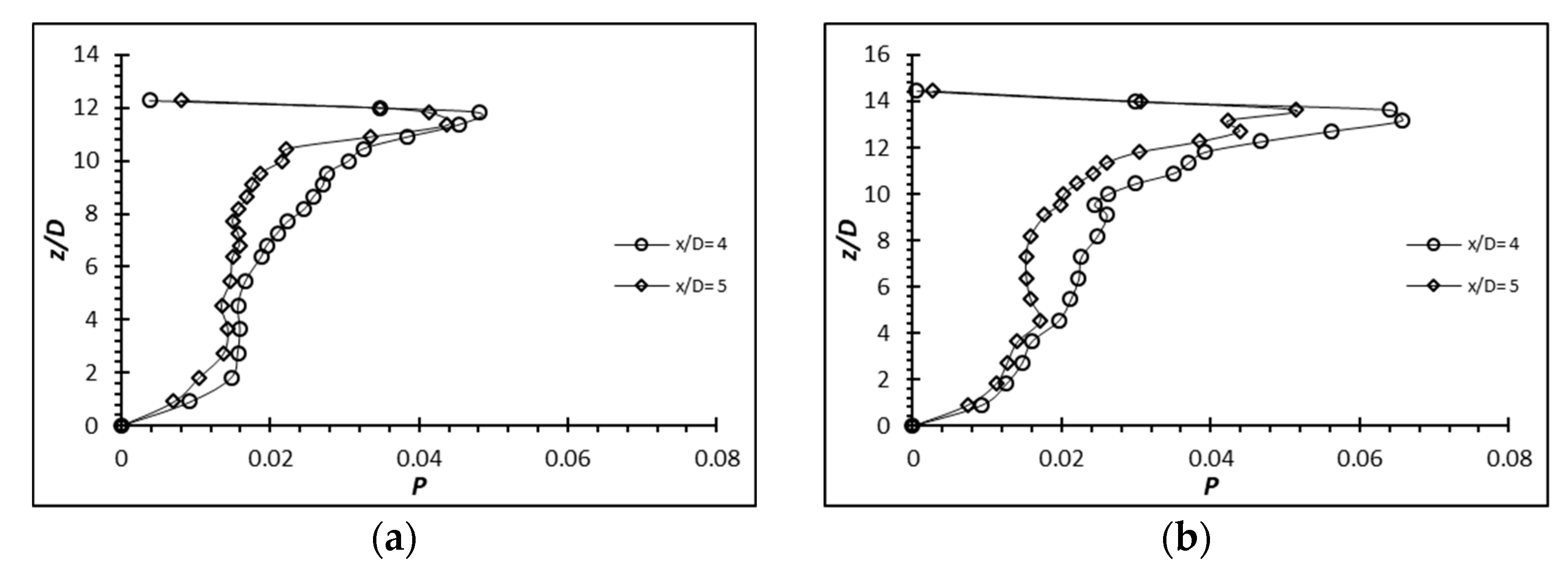
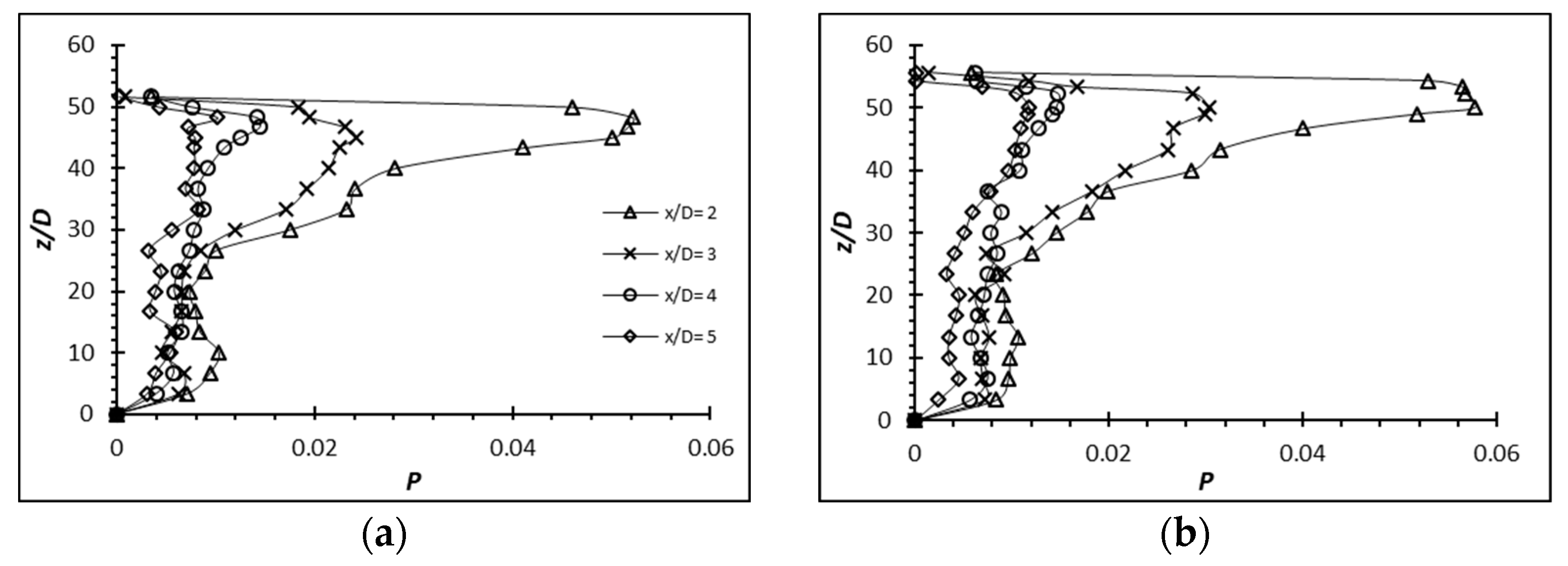

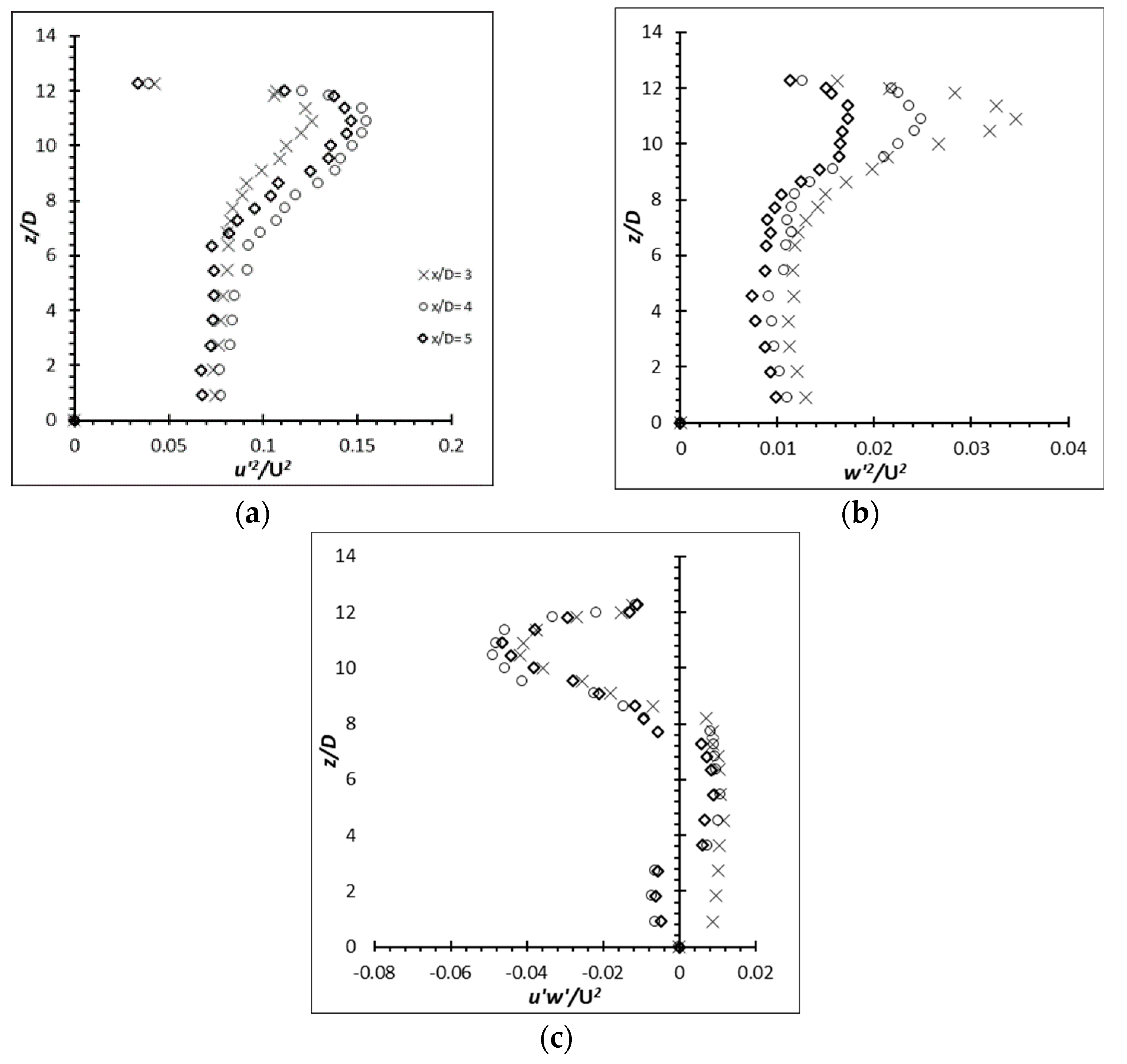
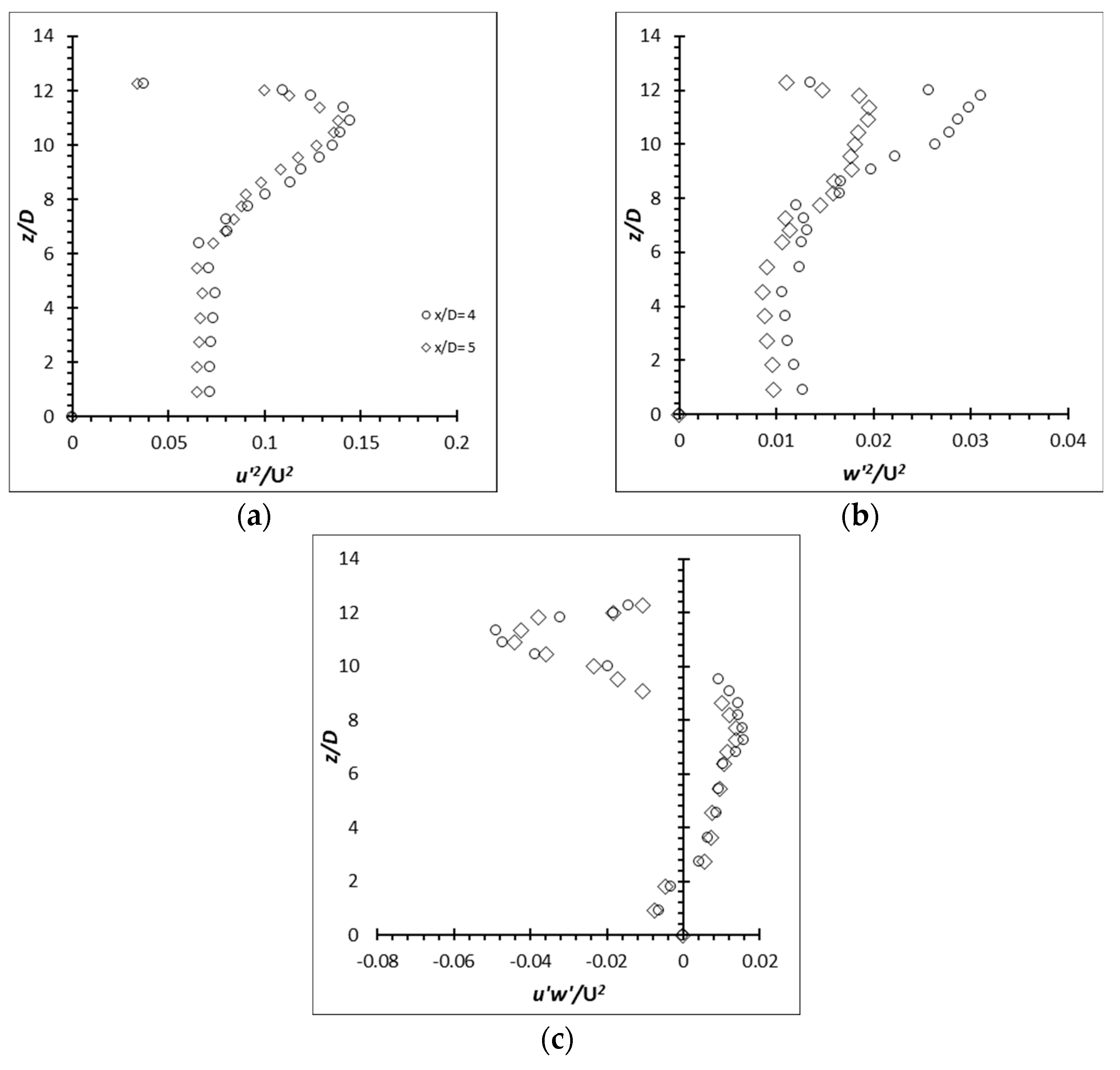
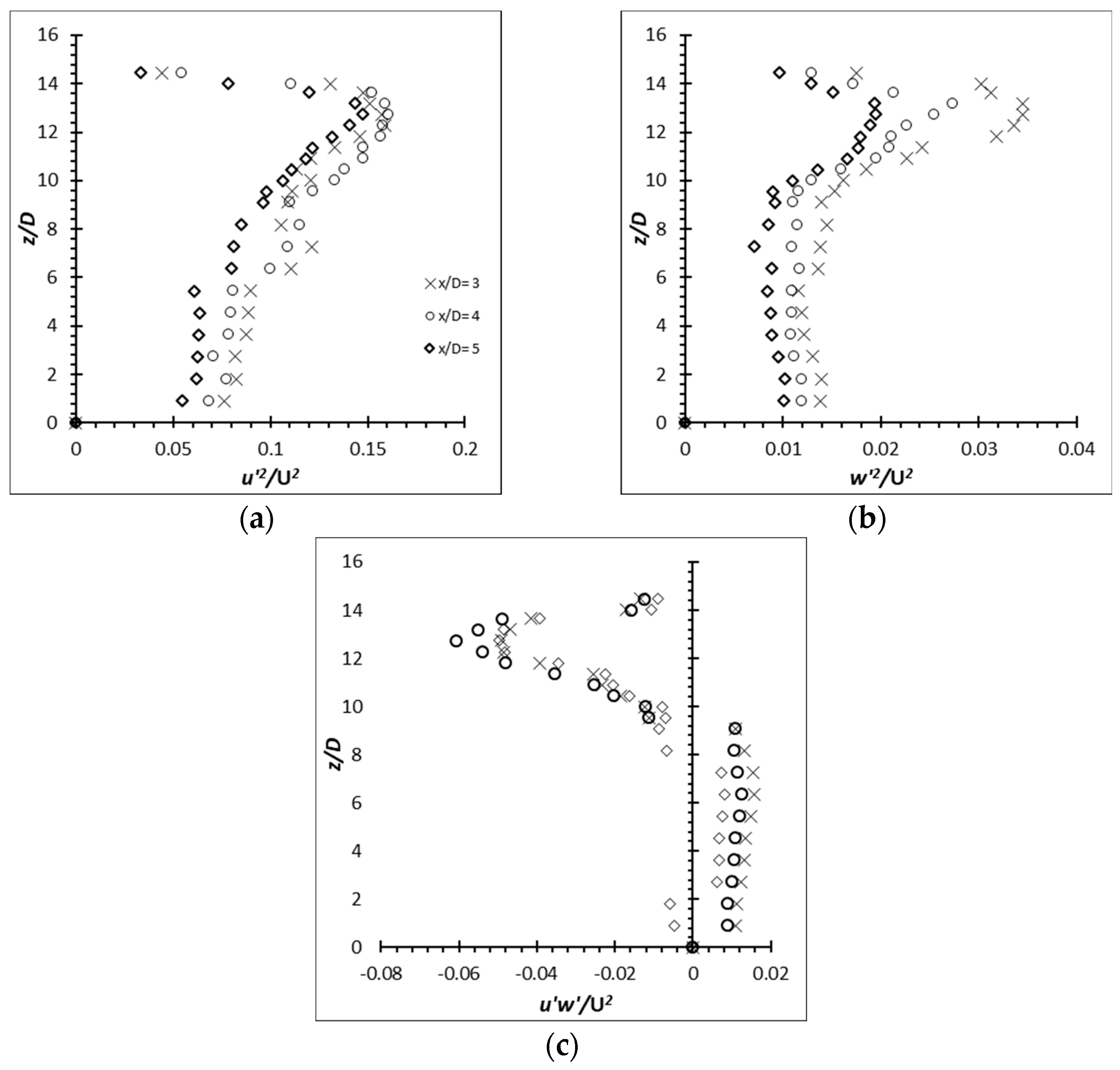
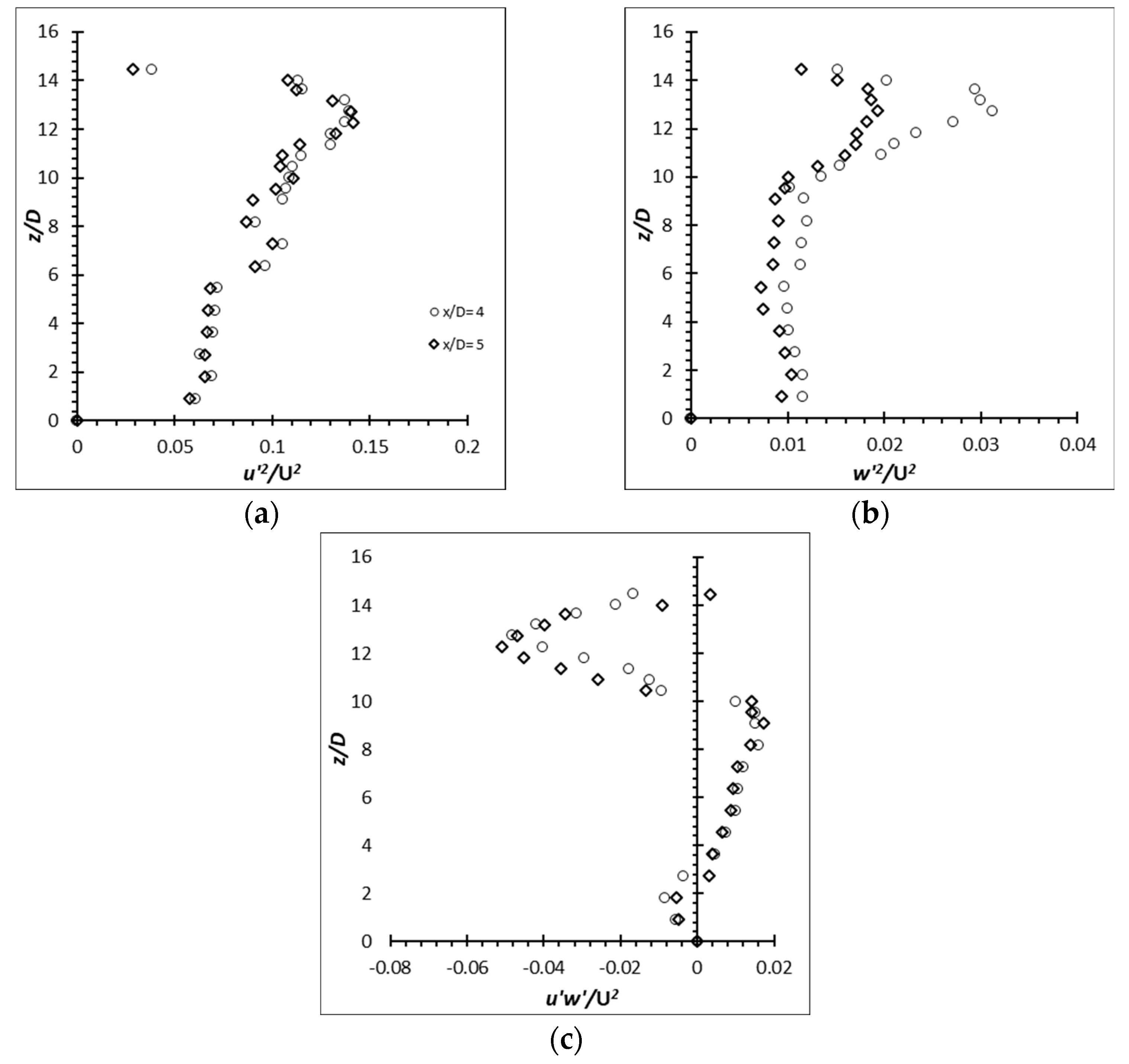




| Location x/D | δ (mm) | δ* (mm) | δθ (mm) | Hδ | ReL × 105 |
|---|---|---|---|---|---|
| −10 | 50 | 11.6 | 8.9 | 1.30 | 0.80 |
| 0 | 54 | 11.9 | 9.9 | 1.20 | 1.28 |
| +10 | 61 | 12.0 | 10.0 | 1.20 | 1.76 |
| Location x/D | δ (mm) | δ* (mm) | δθ (mm) | Hδ | ReL × 105 |
|---|---|---|---|---|---|
| −10 | 52 | 11.7 | 10.1 | 1.15 | 1.19 |
| 0 | 58 | 11.9 | 9.9 | 1.20 | 1.90 |
| +10 | 67 | 12.3 | 10.2 | 1.20 | 2.61 |
| Location x/D | δ (mm) | δ* (mm) | δθ (mm) | Hδ | ReL × 105 |
|---|---|---|---|---|---|
| −10 | 54 | 11.9 | 9.0 | 1.30 | 1.58 |
| 0 | 56 | 11.9 | 9.3 | 1.30 | 2.52 |
| +10 | 60 | 12.0 | 9.4 | 1.30 | 3.45 |
| Aspect Ratio, AR | 10 | 16 |
|---|---|---|
| D (mm) | 13.0 ± 0.5 | 11.0 ± 0.5 |
| L (mm) | 130.0 ± 1 | 176.0 ± 1 |
| δ/D | 4.15, 4.46, 4.30 | 4.90, 5.27, 5.09 |
| δ/H | 0.41, 0.44, 0.43 | 0.30, 0.32, 0.31 |
| Blockage ratio (%) | 4.2 | 4.8 |
| ReD | 4 × 103, 6 × 103, 8 × 103 | 4 × 103, 6 × 103, 8 × 103 |
| Material | Aluminum | Aluminum |
| Young’s modulus (GPa) | 65 | 65 |
| Group | Metal | Polymer |
|---|---|---|
| AR | 50 and 54 | 10, 12, 14 and 16 |
| D (mm) | 3.0 ± 0.5 | 11.0 ± 0.5 |
| L (mm) | 150.0 ± 1, 160.2 ± 1 | 110.0 ± 1, 132.0 ± 1, 154.0 ± 1, 176.0 ± 1 |
| δ/D | 25.0, 26.0 | 4.90, 5.27, 5.09 |
| δ/H | 0.46–0.52 | 0.30–0.52 |
| Blockage ratio (%) | 1.1 and 1.2 | 3.0, 3.6, 4.2, 4.8 |
| ReD | 2.5 × 103 | 4 × 103, 6 × 103, 8 × 103 |
| Material | Aluminum and AISI 12L14 carbon steel | EVA |
| Young’s modulus (GPa) | 65 and 200 | 0.0015 |
| Average Wake Region | |||
|---|---|---|---|
| Material | AR | Re | Average Wake Region |
| EVA | 12 | 4000 | 10.45 D |
| 6000 | 11.30 D | ||
| 8000 | 10.90 D | ||
| 14 | 4000 | 12.27 D | |
| 6000 | 12.27 D | ||
| 8000 | 12.72 D | ||
| Aluminum | 50 | 2500 | 46.67 D |
| 54 | 51.30 D | ||
| Carbon Steel | 50 | 46.67 D | |
| 54 | 50.00 D | ||
Disclaimer/Publisher’s Note: The statements, opinions and data contained in all publications are solely those of the individual author(s) and contributor(s) and not of MDPI and/or the editor(s). MDPI and/or the editor(s) disclaim responsibility for any injury to people or property resulting from any ideas, methods, instructions or products referred to in the content. |
© 2023 by the authors. Licensee MDPI, Basel, Switzerland. This article is an open access article distributed under the terms and conditions of the Creative Commons Attribution (CC BY) license (https://creativecommons.org/licenses/by/4.0/).
Share and Cite
Dol, S.S.; Wee, S.K.; Yong, T.H.; Sulaiman, S.A. The Effects of Flexible Cylinder Structural Dynamics to the near Wake Turbulence. Fluids 2023, 8, 270. https://doi.org/10.3390/fluids8100270
Dol SS, Wee SK, Yong TH, Sulaiman SA. The Effects of Flexible Cylinder Structural Dynamics to the near Wake Turbulence. Fluids. 2023; 8(10):270. https://doi.org/10.3390/fluids8100270
Chicago/Turabian StyleDol, Sharul Sham, Siaw Khur Wee, Tshun Howe Yong, and Shaharin Anwar Sulaiman. 2023. "The Effects of Flexible Cylinder Structural Dynamics to the near Wake Turbulence" Fluids 8, no. 10: 270. https://doi.org/10.3390/fluids8100270
APA StyleDol, S. S., Wee, S. K., Yong, T. H., & Sulaiman, S. A. (2023). The Effects of Flexible Cylinder Structural Dynamics to the near Wake Turbulence. Fluids, 8(10), 270. https://doi.org/10.3390/fluids8100270








